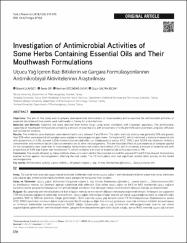| dc.contributor.author | Kulaksiz, Büşra | |
| dc.contributor.author | Er, Sevda | |
| dc.contributor.author | Üstündağ-Okur, Neslihan | |
| dc.contributor.author | Saltan-İşcan, Gülçin | |
| dc.date.accessioned | 2019-10-23T17:56:22Z | |
| dc.date.available | 2019-10-23T17:56:22Z | |
| dc.date.issued | 2018 | |
| dc.identifier.issn | 1304-530X | |
| dc.identifier.uri | https://dx.doi.org/10.4274/tjps.37132 | |
| dc.identifier.uri | https://hdl.handle.net/11421/22930 | |
| dc.description | WOS: 000450780900020 | en_US |
| dc.description.abstract | Objectives: The aim of this study was to prepare pharmaceutical formulations of mouthwashes and to examine the antimicrobial activities of essential oils obtained from plants used traditionally in Turkey for oral infections. Materials and Methods: Essential oils were obtained from herbal drugs using water distillation with Clevenger apparatus. The antimicrobial capacities of mouthwash formulations containing a mixture of essential oils with proportions of 4.5% and 9.0% were examined using disc diffusion and microbroth dilutions. Results: The inhibition zone diameters were determined to vary between 7 and 59 mm. The static and cidal activity was generally 50% and greater than 50% when pure essential oil samples were applied on microorganism specimens. Formulation F2, which contained a mixture of essential oils with proportions of 4.5%, showed 6.25% minimum bactericidal effect on Staphylococcus aureus ATCC 25923, and 3.125% the minimum inhibitory concentration and minimum bactericidal concentration on all other microorganisms. The antimicrobial effect of pure essential oil samples applied on microorganisms was lower than of mouthwashes formulations; the antimicrobial effect of F2, which contained a mixture of essential oils with proportions of 4.5% was higher than formulation F1, which contained a mixture of essential oils with proportions of 9%. Conclusion: The results obtained by these methods allow us to conclude that the essential oils and the prepared F1 and F2 mouthwash formulations exerted activity against microorganisms affecting the oral cavity. The F2 formulation also had significant antimicrobial activity on the tested microorganisms. | en_US |
| dc.language.iso | eng | en_US |
| dc.publisher | Turkish Pharmacists Assoc | en_US |
| dc.relation.isversionof | 10.4274/tjps.37132 | en_US |
| dc.rights | info:eu-repo/semantics/openAccess | en_US |
| dc.subject | Antimicrobial Activity | en_US |
| dc.subject | Laurus Nobilis L. | en_US |
| dc.subject | Origanum Vulgare L. Ssp Hirtum | en_US |
| dc.subject | Rosmarinus Officinalis L. | en_US |
| dc.subject | Salvia Fruticosa Mill | en_US |
| dc.title | Investigation of Antimicrobial Activities of Some Herbs Containing Essential Oils and Their Mouthwash Formulations | en_US |
| dc.type | article | en_US |
| dc.relation.journal | Turkish Journal of Pharmaceutical Sciences | en_US |
| dc.contributor.department | Anadolu Üniversitesi, Yunus Emre Sağlık Hizmetleri Meslek Yüksekokulu, Tıbbi Hizmetler ve Teknikler Bölümü | en_US |
| dc.identifier.volume | 15 | en_US |
| dc.identifier.issue | 3 | en_US |
| dc.identifier.startpage | 370 | en_US |
| dc.identifier.endpage | 375 | en_US |
| dc.relation.publicationcategory | Makale - Uluslararası Hakemli Dergi - Kurum Öğretim Elemanı | en_US] |


















